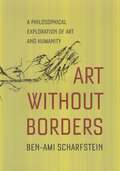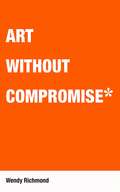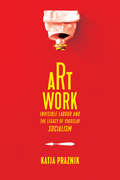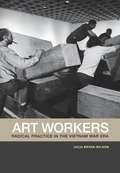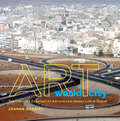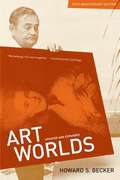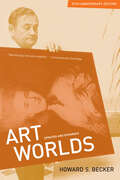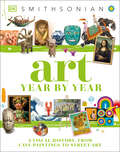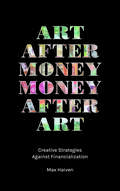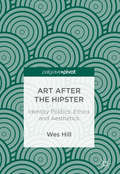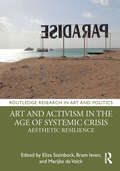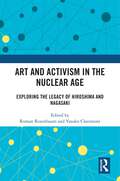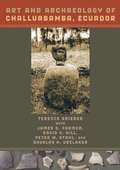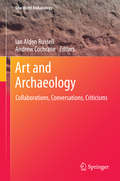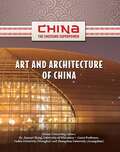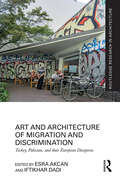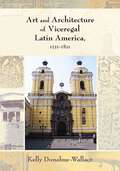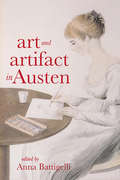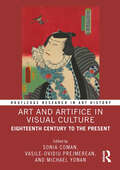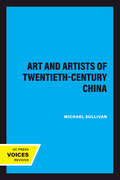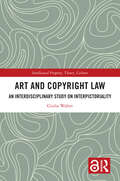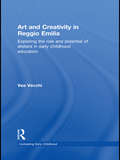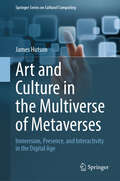- Table View
- List View
Art With Anything: 52 Weeks of Fun Using Everyday Stuff
by Maryann KohlWith 52 weeks of fantastic art projects using easy-to-find, everyday materials, Art with Anything provides a year of creativity, imagination, and fun for children ages 4-10! Organized alphabetically by material, each week features one everyday material (address labels, fabric scraps, leaves, rocks) and provides five days of unique activities, increasing in complexity with each day. Art with Anything uses materials like buttons, cardboard, hole-punch dots, junk mail, masking tape, sandpaper, and salt, which encourages recycling and reusing! Children will love making "Glitter Photo Jars" or working on "Shake-It-Up-Bag Paintings," and projects like "Family Finger Puppets" and "Fluff-N-Puff Mobiles" will keep them entertained for hours and stretch their imaginations. Whether at home or at school, in child care or an after-school program, exploring the process of creating art is one of the most compelling ways children learn, and Art with Anything keeps children learning creatively all year long!
Art Without Borders: A Philosophical Exploration of Art and Humanity
by Ben-Ami ScharfsteinPeople all over the world make art and take pleasure in it, and they have done so for millennia. But acknowledging that art is a universal part of human experience leads us to some big questions: Why does it exist? Why do we enjoy it? And how do the world's different art traditions relate to art and to each other? "Art Without Borders" is an extraordinary exploration of those questions, a profound and personal meditation on the human hunger for art and a dazzling synthesis of the whole range of inquiry into its significance. Esteemed thinker Ben-Ami Scharfstein's encyclopedic erudition is here brought to bear on the full breadth of the world of art. He draws on neuroscience and psychology to understand the way we both perceive and conceive of art, including its resistance to verbal exposition. Continuing in this comparative vein, Scharfstein examines the mutual influence of European and non-European artists. Then, through a comprehensive evaluation of the world's major art cultures, he shows how all of these individual traditions are gradually, but haltingly, conjoining into a single current of universal art. Finally, he concludes by looking at the ways empathy and intuition can allow members of one culture to appreciate the art of another. Lucid, learned, and incomparably rich in thought and detail, "Art Without Borders" is a monumental accomplishment, on par with the artistic achievements Scharfstein writes about so lovingly in its pages.
Art Without Compromise
by Wendy RichmondCombining 24 years of research and insight from her columns in Communication Arts magazine, artist, educator, and writer Wendy Richmond challenges artists to investigate their work through multiple lenses in her newest book, Art Without Compromise*. Her commentaries, exercises, and wide-ranging references to contemporary thinkers will inspire artists to change the way they think about their creative landscape, from personal goals to cultural influences to technological realities. Her insights about major cultural figures, from Roland Barthes to Susan Sontag to Walker Evans, introduce their philosophies into the context of contemporary art making. Like a Malcolm Gladwell for artists, Richmond helps artists to look closely at what they see every day--in their own art making and in the world around them. In the process, she helps artists to develop an uncompromising commitment to finding and protecting their own unique process for making their strongest and most relevant art. This thought-provoking and inspirational book covers such topics as: developing a solid creative process through "Visual Reflection Notebooks" and "Bring Play to Work"; understanding the artist's unique identity in relation to the larger culture; building systems of support and collaboration; explaining how an artist's needs and passions can lead to innovation and authenticity; using language to inspire visual creativity; responding to the Internet and changing concepts of what is public and private; and accepting digression as a creative necessity. Through the exercises and techniques outlined in Art Without Compromise*, the reader will develop new confidence to pursue individual goals and inspiration to explore new paths, along with motivation to overcome creative blocks. With a revised understanding of the relevance in their own work within the sphere of contemporary culture, the artist will come away with a clearer perspective on his or her past and future work and a critical eye for personal authenticity.
Art Work: Invisible Labour and the Legacy of Yugoslav Socialism
by Katja PraznikIn Art Work, Katja Praznik counters the Western understanding of art – as a passion for self-expression and an activity done out of love, without any concern for its financial aspects – and instead builds a case for understanding art as a form of invisible labour. Focusing on the experiences of art workers and the history of labour regulation in the arts in socialist Yugoslavia, Praznik helps elucidate the contradiction at the heart of artistic production and the origins of the mystification of art as labour. This profoundly interdisciplinary book highlights the Yugoslav socialist model of culture as the blueprint for uncovering the interconnected aesthetic and economic mechanisms at work in the exploitation of artistic labour. It also shows the historical trajectory of how policies toward art and artistic labour changed by the end of the 1980s. Calling for a fundamental rethinking of the assumptions behind Western art and exploitative labour practices across the world, Art Work will be of interest to scholars in East European studies, art theory, and cultural policy, as well as to practicing artists.
Art Workers: Radical Practice in the Vietnam War Era
by Julia Bryan-WilsonThis book examines the specific social contexts of the redefinition of artistic labor, showing its centrality to artists' attempts to intervene, through their activism and art making, in a profoundly turbulent moment: the Vietnam War era.
Art World City: The Creative Economy of Artists and Urban Life in Dakar (African Expressive Cultures)
by Joanna Grabski“Insightful . . . should be on the bookshelf of anyone interested in contemporary art on the continent of Africa, its politics, its display, its economics.” —African ArtsArt World City focuses on contemporary art and artists in the city of Dakar, a famously thriving art metropolis in the West African nation of Senegal. Joanna Grabski illuminates how artists earn their livelihoods from the city’s resources, possibilities, and connections. She examines how and why they produce and exhibit their work and how they make an art scene and transact with art world mediators such as curators, journalists, critics, art lovers, and collectors from near and far. Grabski shows that Dakar-based artists participate in a platform that has a global reach. They extend Dakar’s creative economy and the city’s urban vibe into an “art world city.”“In her fine-grained analysis, Joanna Grabski demonstrates the ways that the urban environment and the sites of art production, exhibition, and sale imbricate one another to constitute Dakar as an Art World City.” —Mary Jo Arnoldi, Curator, Anthropology, National Museum of Natural History, Smithsonian“A valuable addition to the anthropology of cities and of art worlds. It stretches and revises the notion of art world to include multiple scales, and illustrates how the city enables simultaneous engagement for artists with local, national, Pan-African, and global discourses and platforms.” —City & Society“A beautiful book. The photographs, most of which are by the author, are stunning.” —College Art Association Reviews
Art Worlds
by Howard S. BeckerThis classic sociological examination of art as collective action explores the cooperative network of suppliers, performers, dealers, critics, and consumers who - along with the artist - "produce" a work of art. Howard S. Becker looks at the conventions essential to this operation and, prospectively, at the extent to which art is shaped by this collective activity. The book is thoroughly illustrated and updated with a new dialogue between Becker and eminent French sociologist Alain Pessin about the extended social system in which art is created, and with a new preface in which the author talks about his own process in creating this influential work.
Art Worlds, 25th Anniversary Edition: 25th Anniversary edition, Updated and Expanded
by Howard S. BeckerThis classic sociological examination of art as collective action explores the cooperative network of suppliers, performers, dealers, critics, and consumers who—along with the artist—"produce" a work of art. Howard S. Becker looks at the conventions essential to this operation and, prospectively, at the extent to which art is shaped by this collective activity. The book is thoroughly illustrated and updated with a new dialogue between Becker and eminent French sociologist Alain Pessin about the extended social system in which art is created, and with a new preface in which the author talks about his own process in creating this influential work.
Art Year by Year: A Visual History, From Cave Paintings to Street Art
by DKTravel through time to discover the paintings, sculptures, and decorative objects that enrich our world.Are you seeking a lavishly illustrated timeline that showcases a glorious gallery of art from all around the world? Then SI Art Year By Year may be the book for you!Over 500 images of art movements such as the Renaissance, Neoclassicism, Impressionism, and Pop Art are explored and explained, accompanied by striking visual detail that truly brings the artwork to life. Further featuring biographies of the key figures behind some of the world&’s best-known artworks, from Botticelli and Hiroshige to Goncharova and Morisot, SI Art Year By Year has something for everyone to admire. With passion in every page, you can explore: - Feature panels discussing artists, art movements, and techniques- Specific works of art analysed, with details pulled out and explained- Pages that explore a single theme through time and across different cultures- Inspiring quotes from artists add insightWith every story plotted on a timeline, the pages give a snapshot of each era, and reveal the influences and connections behind the artworks and artistic movements that have reflected our world. With more than 500 images of paintings, drawings, photographs, and sculptures, SI Art Year by Year is the ultimate visual guide to the history of art, century by century, year by year!A must-have art book for children and adults alike who are curious about art, whether you&’re an educator, an art enthusiast, or a lover of creativity seeking to explore some of the greatest known artworks throughout history, SI Art Year By Year is sure to delight.
Art after Money, Money after Art: Creative Strategies against Financialization
by Max HaivenWe imagine that art and money are old enemies, but this myth actually reproduces a violent system of global capitalism and prevents us from imagining and building alternatives. From the chaos unleashed by the ‘imaginary’ money in financial markets to the new forms of exploitation enabled by the ‘creative economy’ to the way art has become the plaything of the world’s plutocrats, our era of financialization demands that we question our romantic assumptions about art and money. By exploring the way contemporary artists engage with cash, debt, and credit, Haiven identifies and assesses a range of creative strategies for mocking, sabotaging, exiting, decrypting, and hacking capitalism today. Written for artists, activists, and scholars, this book makes an urgent call to unleash the power of the radical imagination by any media necessary.
Art after the Hipster: Identity Politics, Ethics and Aesthetics
by Wes HillThis book examines the complexities of the hipster through the lens of art history and cultural theory, from Charles Baudelaire's fl#65533;neur to the contemporary "creative" borne from creative industries policies. It claims that the recent ubiquity of hipster culture has led many artists to confront their own significance, responding to the mass artification of contemporary life by de-emphasising the formal and textual deconstructions so central to the legacies of modern and postmodern art. In the era of creative digital technologies, long held characteristics of art such as individual expression, innovation, and alternative lifestyle are now features of a flooded and fast-paced global marketplace. Against the idea that artists, like hipsters, are the "foot soldiers of capitalism", the institutionalized networks that make up the contemporary art world are working to portray a view of art that is less a discerning exercise in innovative form-making than a social platform--a forum for populist aesthetic pleasures or socio-political causes. It is in this sense that the concept of the hipster is caught up in age-old debates about the relation between ethics and aesthetics, examined here in terms of the dynamics of global contemporary art.
Art and Activism in the Age of Systemic Crisis: Aesthetic Resilience (Routledge Research in Art and Politics)
by Marijke De Valck Eliza Steinbock Bram IevenThis book examines how renewed forms of artistic activism were developed in the wake of the neoliberal repression since the 1980s. The volume shows the diverse ways in which artists have sought to confront systemic crises around the globe, searching for new and enduring forms of building communities and reimagining the political horizon. The authors engage in a dialogue with these artistic efforts and their histories – in particular the earlier artistic activism that was developed during the civil rights era in the 1960s and 70s – providing valuable historical insight and new conceptual reflection on the future of aesthetic resilience. This book will be of interest to scholars in contemporary art, history of art, film and literary studies, protest movements, and social movements.
Art and Activism in the Nuclear Age: Exploring the Legacy of Hiroshima and Nagasaki
by Yasuko Claremont Roman RosenbaumThis book explores the contemporary legacy of Hiroshima and Nagasaki following the passage of three quarters of a century, and the role of art and activism in maintaining a critical perspective on the dangers of the nuclear age. It closely interrogates the political and cultural shifts that have accompanied the transition to a nuclearised world. Beginning with the contemporary socio-political and cultural interpretations of the impact and legacy of the destruction of Hiroshima and Nagasaki, the chapters examine the challenges posed by committed opponents in the cultural and activist fields to the ongoing development of nuclear weapons and the expanding industrial uses of nuclear power. It explores how the aphorism that "all art is political" is borne out in the close relation between art and activism. This multi-disciplinary approach to the socio-political and cultural exploration of nuclear energy in relation to Hiroshima/Nagasaki via the arts will be of interest to students and scholars of peace and conflict studies, social political and cultural studies, fine arts, and art and aesthetic studies.
Art and Archaeology of Challuabamba, Ecuador
by Terence GriederChalluabamba (chī-wa-bamba)--now a developing suburb of Cuenca, the principal city in the southern highlands of Ecuador--has been known for a century as an ancient site that produced exceptionally fine pottery in great quantities. Suspecting that Challuabamban ceramics might provide a link between earlier, preceramic culture and later, highly developed Formative period art, Terence Grieder led an archaeological investigation of the site between 1995 and 2001. In this book, he and the team of art historians and archaeologists who excavated at Challuabamba present their findings, which establish the community's importance as a center in a network of trade and artistic influence that extended to the Amazon River basin and the Pacific Coast. Art and Archaeology of Challuabamba, Ecuador presents an extensive analysis of ceramics dating to 2100-1100 BC, along with descriptions of stamps and seals, stone and shell artifacts, burials and their offerings, human remains, and zooarchaeology. Grieder and his coauthors demonstrate that the pottery of Challuabamba fills a gap between early and late Formative styles and also has a definite connection with later highland styles in Peru. They draw on all the material remains to reconstruct the first clear picture of Challuabamba's prehistory, including agriculture and health, interregional contacts and exchange, red-banded incised ware and ceramic production, and shamanism and cosmology. Because southern Ecuador has received relatively little archaeological study, Art and Archaeology of Challuabamba, Ecuador offers important baseline data for what promises to be a key sector of the prehistoric Andean region.
Art and Archaeology: Collaborations, Conversations, Criticisms (One World Archaeology #11)
by Ian Alden Russell Andrew CochraneThis volume presents a collection of interdisciplinary collaborations between contemporary art, heritage, anthropological, and archaeological practitioners. Departing from the proceedings of the Sixth World Archaeological Congress's 'Archaeologies of Art' theme and Ábhar agus Meon exhibitions, it includes papers by seminal figures as well as experimental work by those who are exploring the application of artistic methods and theory to the practice of archaeology. Art and archaeology: collaborations, conversations, criticisms encourages the creative interplay of various approaches to 'art' and 'archaeology' so these new modes of expression can contribute to how we understand the world. Established topics such as cave art, monumental architecture and land art will be discussed alongside contemporary video art, performance art and relational arts practices. Here, the parallel roles of artists as makers of new worlds and archaeologists as makers of pasts worlds are brought together to understand the influences of human creativity.
Art and Architecture of China (China: The Emerging Superpower)
by Shelia Hollihan-ElliotChina has a rich artistic tradition extending back thousands of years. Art and Architecture of China surveys the art treasures of this vibrant civilization, from ancient and imperial China to today's People's Republic. The arts of each era are interpreted in the context of the life, culture, and politics of that era, offering insights to their meaning and showing how China's artistic output has reflected the development of Chinese society and thought. Art forms studied include ancient bronze ritual vessels and jade; the Three Perfections (calligraphy, poetry, and brush painting); ceramics and porcelain; sculpture; decorative and folk art; and modern, Western-influenced painting. Traditional Chinese architecture and town planning is also explored, revealing key technologies and design principles. In addition, today's interplay between traditional architecture and cutting-edge modernism is examined.
Art and Architecture of Migration and Discrimination: Turkey, Pakistan, and their European Diasporas (Routledge Research in Architecture)
by Iftikhar Dadi Esra AkcanThis book brings together essays by established and emerging scholars that discuss Pakistan, Turkey, and their diasporas in Europe. Together, the contributions show the scope of diverse artistic media, including architecture, painting, postcards, film, music, and literature, that has responded to the partitions of the twentieth century and the Muslim diasporas in Europe. Turkey and Pakistan have been subject to two of the largest compulsory population transfers of the twentieth century. They have also been the sites for large magnitudes of emigration during the second half of the twentieth century, creating influential diasporas in European cities such as London and Berlin. Discrimination has been both the cause and result of migration: while internal problems compelled citizens to emigrate from their countries, blatant discriminatory and ideological constructs shaped their experiences in their countries of arrival. Read together, the Partition emerges from the essays in Part I not as a pathology specific to the Balkans, Middle East, or South Asia, but as a central problematic of the new political realities of decolonization and nation formation. The essays in Part II demonstrate the layered histories and multiple migration paths that have shaped the experiences of Berliners and Londoners. This analysis furthers the study of modernism and migration across the borders of, not only the nation-state, but also class, race, and gender. As a result, this book will be of interest to a broad multidisciplinary academic audience including students and faculty, artists, architects and planners, as well as non-specialist general public interested in visual arts, architecture and urban literature.
Art and Architecture of Viceregal Latin America, 1521-1821 (Diálogos Series)
by Kelly Donahue-WallaceKelly Donahue-Wallace surveys the art and architecture created in the Spanish Viceroyalties of New Spain, Peru, New Granada, and La Plata from the time of the conquest to the independence era. Emphasizing the viceregal capitals and their social, economic, religious, and political contexts, the author offers a chronological review of the major objects and monuments of the colonial era. In order to present fundamental differences between the early and later colonial periods, works are offered chronologically and separated by medium - painting, urban planning, religious architecture, and secular art - so the aspects of production, purpose, and response associated with each work are given full attention. Primary documents, including wills, diaries, and guild records are placed throughout the text to provide a deeper appreciation of the contexts in which the objects were made.
Art and Artifact in Austen (Victorian Literature and Culture Series)
by Anna BattigelliJane Austen distinguished herself with genius in literature, but she was immersed in all of the arts. Austen loved dancing, played the piano proficiently, meticulously transcribed piano scores, attended concerts and art exhibits, read broadly, wrote poems, sat for portraits by her sister Cassandra, and performed in theatricals. For her, art functioned as a social bond, solidifying her engagement with community and offering order. And yet Austen’s hold on readers’ imaginations owes a debt to the omnipresent threat of disorder that often stems—ironically—from her characters’ socially disruptive artistic sensibilities and skill. Drawing from a wealth of recent historicist and materialist Austen scholarship, this timely work explores Austen’s ironic use of art and artifact to probe selfhood, alienation, isolation, and community in ways that defy simple labels and acknowledge the complexity of Austen’s thought.
Art and Artifice in Visual Culture: Eighteenth Century to the Present (Routledge Research in Art History)
by Michael Yonan Sonia Coman Vasile-Ovidiu PrejmereanThis edited volume explores the notion of “artifice” in modern visual culture, ranging from the eighteenth century to the present, in countries around the globe.Artifice has been regarded as a primarily Western phenomenon, playing as it does a central role in European art theory since the Renaissance. This volume proposes that artifice is better understood as a transcultural artistic phenomenon and requires far broader conceptualization across international contexts. It acquaints readers with works of art, visual modes of communication, and concepts originating in France, Germany, the United States, Japan, and China, and includes painting, sculpture, drawings, prints, photographs, film, and virtual reality/augmented reality (VR/AR) objects. Contributors demonstrate how practices of artifice function as both symbol and form, in parallel and divergent ways, in multiple cultural settings.The book will be of interest to scholars working in art history, visual culture, and material culture.
Art and Artists of Twentieth-Century China
by Michael SullivanThis visually stunning book focuses on the rebirth of Chinese art in the twentieth century under the influence of Western art and culture. Michael Sullivan, recognized throughout the world as a leading scholar of Chinese art, vividly documents the conflicting pulls of traditional and Western values on Chinese art and provides 364 illustrations, in color and black-and-white, to show the great range of artistic expression and the historical processes that occurred within various movements. A substantial biographical index of twentieth-century Chinese artists is a valuable addition to the text.Sullivan discusses artists and their work against China's background of oppression and relaxation, despair and hope. He expertly conveys the diverse and at times bizarre intertwining of Chinese cultural history and art during this century. Included are the intense debates between traditionalists and reformers, the creation of the first art schools, and the birth of the idea—shocking in ethnocentric China—that art is a world language that obliterates all frontiers. The scholarly traditions of classical Chinese painting, the belated discovery of Western modernism, the artistic upheaval under Communism, and China's rethinking of the very nature of art all have a place in Sullivan's fascinating history.Michael Sullivan has known many of the major figures in China's modern art movement of the 1930s and 1940s and has also gained the confidence of younger artists who rose to prominence following the 1979 "Peking Spring." This long-awaited book—richly documented and abundantly illustrated—is a capstone to Sullivan's work and will be enthusiastically welcomed by art lovers everywhere.
Art and Copyright Law: An Interdisciplinary Study on Interpictoriality (Intellectual Property, Theory, Culture)
by Giulia WalterThis book tackles the lack of synchronicity between art and copyright law, proposing practical and interdisciplinary tools through which to navigate this conflict.In the last decades, high profile lawsuits have been filed against artists accused of plagiarism including Jeff Koons, Barbara Kruger and Andy Warhol. This book demonstrates how these cases are at odds with contemporary artistic reality, in which the use of antecedent visual forms is common practice. Focusing on the dichotomies of “original/copy” and of “old/new”, this work addresses this phenomenon from both theoretical and legal perspectives. Using Swiss copyright law as the main case study, the book comparatively assesses other international legal frameworks. Through understanding the origins of the conflict between art and copyright, the book highlights solutions to handle copyright cases with a new methodological approach.The book will be of interest to researchers in the field of art and copyright law, intellectual property and art.The Open Access version of this book, available at http://www.taylorfrancis.com, has been made available under a Creative Commons Attribution-Non Commercial-No Derivatives (CC BY-NC-ND) 4.0 license.
Art and Cosmotechnics (e-flux)
by Yuk HuiIn light of current discourses on AI and robotics, what do the various experiences of art contribute to the rethinking of technology today?Art and Cosmotechnics addresses the challenge of technology to the existence of art and traditional thought, especially in light of current discourses on artificial intelligence and robotics. It carries out an attempt on the cosmotechnics of Chinese landscape painting in order to address this question, and further asks: What is the significance of shanshui (mountain and water) in face of the new challenges brought about by the current technological transformation? Thinking art and cosmotechnics together is an attempt to look into the varieties of experiences of art and to ask what these experiences might contribute to the rethinking of technology today.
Art and Creativity in Reggio Emilia: Exploring the Role and Potential of Ateliers in Early Childhood Education (Contesting Early Childhood)
by Vea VecchiThis book explores the contribution of and art and creativity to early education, and examines the role of the atelier (an arts workshop in a school) and atelierista (an educator with an arts background) in the pioneering pre-schools of Reggio Emilia. It does so through the unique experience of Vea Vecchi, one of the first atelieristas to be appointed in Reggio Emilia in 1970. Part memoir, part conversation and part reflection, the book provides a unique insider perspective on the pedagogical work of this extraordinary local project, which continues to be a source of inspiration to early childhood practitioners and policy makers worldwide. Vea’s writing, full of beautiful examples, draws the reader in as she explains the history of the atelier and the evolving role of the atelierista. Key themes of the book include: • processes of learning and knowledge construction • the theory of the hundred languages of childhood and the role of poetic languages • the importance of organisation, ways of working and tools, in particular pedagogical documentation • the vital contribution of the physical environment • the relationship between the atelier, the atelierista, the school and its teachers This enlightening book is essential reading for students, practitioners, policy makers and researchers in early childhood education, and also for all those in other fields of education interested in the relationship between the arts and learning.
Art and Culture in the Multiverse of Metaverses: Immersion, Presence, and Interactivity in the Digital Age (Springer Series on Cultural Computing)
by James HutsonDrawing on the art historical framing of Location, Place, and Identity, this book will examine how the factors of Immersion, Presence, and Interactivity of XR are shaping our understanding of the world and our place within it. Location refers to the specific geographical or spatial context in which a work of art is created or experienced. Place refers to the social, cultural, and historical context of that location. Identity refers to the ways in which individuals and communities construct and express their sense of self and belonging within those contexts. Through case studies and theoretical analysis, Art and Culture in the Multiverse of Metaverses - Immersion, Presence, and Interactivity in the Digital Age, will explore how the factors of Immersion, Presence, and Interactivity of XR can be aligned with these art historical concepts, providing new opportunities for understanding and engaging with Location, Place, and Identity. For example, XR can be used to create immersive experiences of historical locations and cultural sites, allowing users to explore and engage with them in ways that would otherwise be impossible. Additionally, XR can be used to create interactive artworks that engage with issues of identity and belonging, creating new possibilities for self-expression and exploration.

